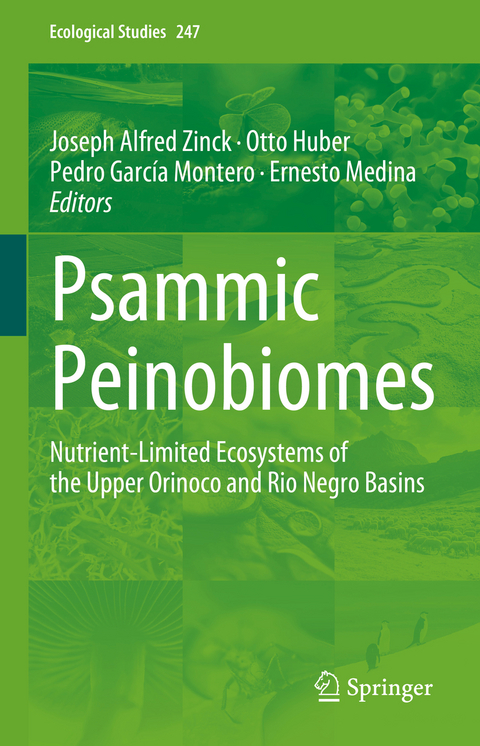
Psammic Peinobiomes
Springer International Publishing (Verlag)
978-3-031-20798-3 (ISBN)
Alfred Zinck: Bachelor in Geography and Master in Edaphology and Geomorphology, University of Strasbourg, France. Doctorate in Regional Planning, University of Bordeaux, France. Postdoc Soil Science Dept. University of California Berkeley, USA. Emeritus Prof., Faculty of Geo-information Science and Earth Observation (ITC), University of Twente, Enschede, The Netherlands. Otto Huber: Bachelor in Biology (1969) Università degli Studi di Roma, Roma (Italy). Doctor degree in Botany and Geography, Leopold-Franzens- Universität, Innsbruck (Austria) 1976. Specialist in neotropical floristics and phytogeography, (the Guayana region, the Orinoco savannas, and the cloud forest of the coastal range in Venezuela). Ecologist of Ministry for the Environment (MARNR-CODESUR), Amazonas state (1977-1983). Scientific consultant (CVG - EDELCA) and (MARNR) for ecology, and environmental impact (1986-1992)(Venezuela). Coordinator, Deutsche Gesellschaft für Technische Zusammenarbeit (GTZ)/Germany (1992-1994) (project: Amazonian Center for Environmental Research (CAIAH), Amazonas state, Venezuela). Pedro García Montero: Ing. Agr. Universidad Central de Venezuela (UCV) 1975. Master of Science (Soil Science), University of Florida, USA (1984).Long-term staff member of the governmental electric power company (CVG – EDELCA, Venezuela) and Ministry of the Environment (MARNR). Professor of Soil Science at the Universidad Central de Venezuela (UCV). Environmental Consultant. Member of the Orinoco Group. Ernesto Medina: Bachelor in Biology (1961), Universidad Central de Venezuela (UCV). Doktor Acker, Universität Hohenheim, Germany (1964). Postdoc. Department of Plant Biology, Carnegie Institution of Washington, USA (1970). Emeritus Researcher, Instituto Venezolano de Investigaciones Científicas (IVIC). Adjunct Scientist of the International Institute of Tropical Forestry (USDA), Puerto Rico.
1 Introduction.- Part I: Forest and woodland biomes.- 2 White sand ecosystems in the Amazon basin: geographic distribution, distinctive features, and ecology. An overview.- 3 The forests of the Rio Negro basin in the north-western Amazon: a phytosociological classification.- 4 Amazon caatinga complex: sclerophyllous vegetation on nutrient-poor white sand soils.- Part II: Meadow biomes.- 5 Mapping white-sand ecosystems by integrating Global PALSAR-2 and SENTINEL-1 with NDVI (LANDSAT data).- 6 The study areas: landscapes and soils.- 7 Soil properties, formation, distribution, and classification.- 8 Origin and sources of sand: from highlands to lowlands.- 9 Sand dynamics and distribution: a geo-sedimentological approach.- 10 Features and trends of meadow landscape evolution.- 11 Meadow phytodiversity: flora, endemism, vegetation types, and geographic distribution patterns.- 12 Synthesis: white-sand and meadow-vegetation relationships.
| Erscheinungsdatum | 02.12.2022 |
|---|---|
| Reihe/Serie | Ecological Studies |
| Zusatzinfo | XIV, 541 p. 136 illus., 122 illus. in color. |
| Verlagsort | Cham |
| Sprache | englisch |
| Maße | 155 x 235 mm |
| Gewicht | 992 g |
| Themenwelt | Naturwissenschaften ► Biologie ► Botanik |
| Naturwissenschaften ► Biologie ► Ökologie / Naturschutz | |
| Weitere Fachgebiete ► Land- / Forstwirtschaft / Fischerei | |
| Schlagworte | Amazon Basin • Caatinga • dystrophic soils • endemism • forest and herbaceous ecosystems • geopedology • landscape evolution and vulnerability • Orinoco • Phytodiversity • Plant Communities • plant physiological ecology • Rio Negro • tropical peinobiomes • vegetation and soil sampling • white-sand ecosystems • white-sand forests • white-sand meadows |
| ISBN-10 | 3-031-20798-X / 303120798X |
| ISBN-13 | 978-3-031-20798-3 / 9783031207983 |
| Zustand | Neuware |
| Informationen gemäß Produktsicherheitsverordnung (GPSR) | |
| Haben Sie eine Frage zum Produkt? |
aus dem Bereich


